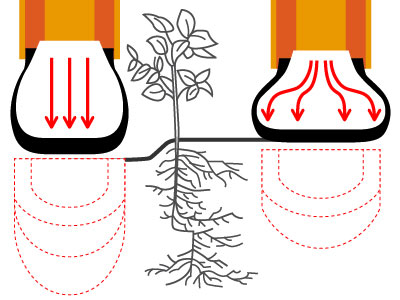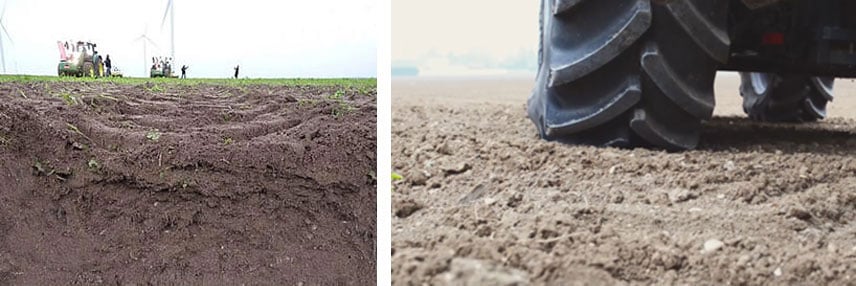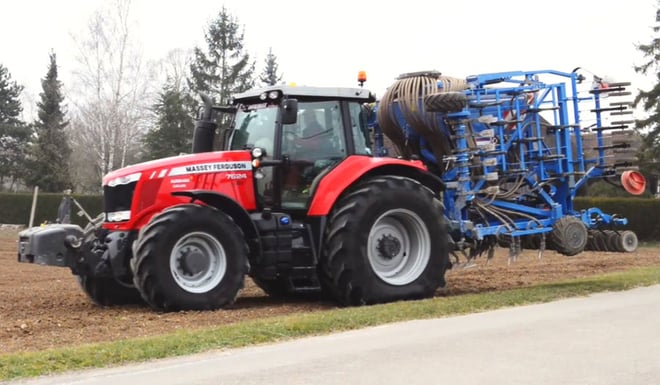You are equipped with VF tyres, but like a large number of users with this top-of-the range equipment, you have got into the practice of working most of the time with an average inflation pressure to simplify life and not have to think about your tyres.
However, if you use your tyres to their full capacity, you can gain much more than just peace of mind, with real financial savings, in fuel and working time or soil preservation with better yields to look forward to after a few years.
By making better use of very low pressure, you can make savings quite simply just by using the capacities of the tyres that you have already paid for.
It's true that VF tyres are perfectly operational at an average inflation pressure of 1.4 bar. Thanks to their reinforced structure which means that they can bear up to 40% more load than a standard tyre, there should be no immediate problem for daily use without adjusting the settings.
But if you choose to use your precision equipment at a low inflation pressure, exactly as intended by the manufacturer, this will procure an incomparable economic result for you.
Here is how a VF tyre like the VT-TRACTOR tyre used at low pressure can bring you real savings:
1. Low-pressure VF tyres, advantages for your soil: Better yields, soil aeration savings
Unlike standard technology tyres which require high pressure when carrying a load, VF tyres have the capacity to work frequently at an inflation pressure of 0.8 bar despite the load, thanks to their supple, reinforced sidewalls.
This is an enormous advantage because it spreads the weight of the tractor and its implements over a larger contact patch with the ground, thus considerably minimising the effect of soil compaction.
The use of VF agricultural tyres at very low pressure helps to avoid soil compaction, with the following effects:
- Protecting the growth of the crops’ root system.
- Preserving biological activity in the soil.
- Enabling good water infiltration into the different layers of soil.
- Providing water reserves in the lower layers of soil to optimise yields without watering during the dry season.

On the right, VF tyres inflated to 0.8 bar
have less impact on the root system
Less compaction for better crop yields
These technological tyres which preserve your soil allow your crops to develop more evenly and grow in the best conditions, ensuring you obtain better yields in the long run.
For example, they will be particularly efficient for spring crops (spring barley, corn, peas, sunflower), or for autumn work when the soil is very sensitive to compaction during wet periods.
 Test performed with a 320 hp John Deere 8320
Test performed with a 320 hp John Deere 8320
with 800/70R38 VT-TRACTOR tyres inflated to 0.8 bar:
no compaction, the soil is still crumbly
No soil aeration work required with VF tyres
The repeated passage of tractor tyres, trailers or any other agricultural machinery over the same area leads to soil compaction, especially if you use standard tyres with a high inflation pressure.
In general, this obliges you to take corrective action such as soil aeration work in order to improve and rehabilitate your soil structure.
This decompaction work involves soil aeration, breaking up the plough pan and thus allowing water and air to circulate within the deep layers of soil.
This type of intervention is costly in time and fuel because the in-depth operation requires a great deal of energy expenditure.
Working regularly with low-pressure VF tyres avoids all these unnecessary expenses since these tyres are designed to reduce the risk of soil compaction as much as possible.
2. Low-pressure VF tyres, advantage for traction: less slip, less wear, quicker work
The tyre is the intermediary which ensures contact between the tractor and the ground. There’s no point having a powerful agricultural machine without quality tyres. The tractive effort is transmitted to the ground by your tyres and more precisely thanks to the tyre lugs; the better they are adapted to the ground, the longer and more resistant they are, the better the traction capacity will be, even on loose soil.
By working at an inflation pressure of 0.8 bar with a VF tyre, it will tend to sink less deeply into the soil, crushing into the ground at surface level, thus increasing the width, but above all the length of its soil footprint. Obviously if the contact patch increases, the number of lugs gripping the soil increases also, mechanically increasing your tractor’s traction capacity.
 Working at low inflation pressure with VF VT-TRACTOR tyres
Working at low inflation pressure with VF VT-TRACTOR tyres
Working at low inflation pressure reduces the slip ratio
For optimal working conditions, minimum slip is necessary.
The ideal slip ratio for a tractor is considered to be between 12 and 15%.
With VF tyres which have a large contact patch with the ground, controlling the slip ratio is easier, given that for the VT TRACTOR tyre for example, the lugs also have a specific rounded multiple angle design which facilitates traction and avoids earth accumulating between the lugs.
With reduced slip, the tyre slides over the ground less, the job is completed more rapidly and your tyres wear less quickly, which means you save money by having to replace them less frequently.
 Test involving a change of pressure in the same field:
Test involving a change of pressure in the same field:
On the left 1 bar pressure, on the right 1.24 bar pressure
3. Low-pressure VF tyres, advantage for fuel consumption: a better soil footprint, less rolling resistance
VF tyres such as the VT-TRACTOR are the fruit of several years of research and development and have a special lug design, with the thickness, size and angle carefully optimised to penetrate perfectly into the ground.
The "involute" lug has been developed to ensure that the tractor’s power is transmitted to the ground, just like a cog wheel which transmits force more efficiently, with the least possible loss of energy.
The construction of the casing and the lug profiles are designed to ensure better self-cleaning of the surface of the tyre, before it comes back into contact with the ground.
When these VF tyres work at low pressure, you obtain a bigger soil footprint with more lugs working at the same time. They generate more horizontal traction and therefore transmit the tractive effort more efficiently to the ground. The vertical force, which pushes the tyre deeper into the ground, is minimised in favour of forward moving traction.
Work is therefore carried out without any loss of power and fuel consumption decreases.
Less rolling resistance means more working power
If you use standard tyres you are obliged to overinflate your tyres to bear the weight of your implements and on soft or wet ground this is not how to work in the best conditions.
Overinflated tyres effectively sink further into the ground, leading to increased rolling resistance, excessive slip and forcing you to accelerate more to compensate for the loss of grip and transmit the tractive effort to the ground better.
The more engine power is required, the more your fuel consumption rises.
 VF VT-TRACTOR tyres inflated to 0.8 bar to reduce fuel consumption
VF VT-TRACTOR tyres inflated to 0.8 bar to reduce fuel consumption
VF tyres used at low pressure spread the mass over a larger surface area on the ground without sinking in, which has the advantage of reducing rolling resistance, above all on wet ground.
Your slip ratio will be lower and your agricultural machine will have more power available for the same amount of work, so you will save on fuel.
4. How to get used to low pressure with VF tyres
Some VF tyre users hesitate to reduce pressure, mistakenly thinking that this could alter the structure of the tyre.
Good use of a VF technology tyre allows you to make a few trips from road to field with the same inflation pressure defined on the basis of the load to be carried.
The internal structure of the tyre allows it to work normally at low pressure without altering the integrity of the tyre.
Extensive driving flexibility
Although VF tyres have many advantages in terms of soil preservation, traction and fuel consumption, it is possible that some users will not appreciate how the tractor handles driving on the road with a low inflation pressure.
It does take a little time to get used to this technology which is different from the more rigid standard tyres.
Driving quality is more fluid, because these technological tyres are much more supple at the level of the sidewalls, which gives a false impression of lateral sway compared to tyres with harder sidewalls.
When cornering, a slight lag linked to the suppleness of the tyres may give a discomforting impression of lack of responsiveness. This is very slight but can be destabilising to begin with, until you get accustomed to it, especially if you are used to driving with highly inflated standard tyres.
The Bridgestone-agriculture.eu blog is written and administered by tractor tyre experts who are available to provide you with the advice you need on the subject of your agricultural tyres. They allow you to maximise your productivity with information on all subjects linked to tyres: Cheap tractor tyres — Technical data for agricultural tyres — Air pressure advice — Solutions to avoid soil compaction — Sprayer tyre pressure — Why and how to ballast your tractor tyres — When to use dual wheels — The mechanical causes of abnormal wear — Cheap agricultural tyres – etc.
To learn more and boost your farm's profits, Bridgestone-Agriculture is offering you a free, detailed white paper that explains the essential role your agricultural tyres play in your productivity.
Most people who read this article have also read some of the following articles:
- 5 essential techniques to optimise your agricultural tyres
- Agricultural contractors: improving quality of service with an adapted agricultural tyre
- Which vibrations are directly linked to agricultural tyres?
- Load comparison between standard agricultural tyres and VF tyres
- Impact of the loaded radius for my agricultural tyres
- VF agricultural tyres versus caterpillars: Pros and cons
- Why should you check your harvesting tyres before the start of the harvest?
- Which agricultural tyre makes it possible to avoid coming off the rim at low pressure?
- What is the impact of implement settings on tractor tyres?
- Fleet audit: what is the main benefit of agricultural tyres?
This information is intended only to make you aware of the technical and functional aspects of agricultural tires and their use. It does not allow you to make a judgment or a definitive conclusion on a given problem. Only your agricultural tire expert is able to make a technical assessment and take a final decision, case by case.
Leave a
commentary
Your email address will not be published.
Required fields are indicated with *








